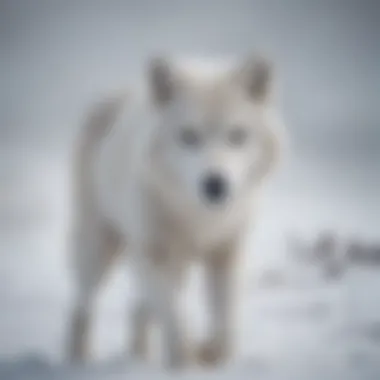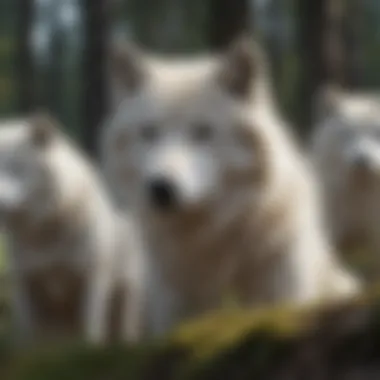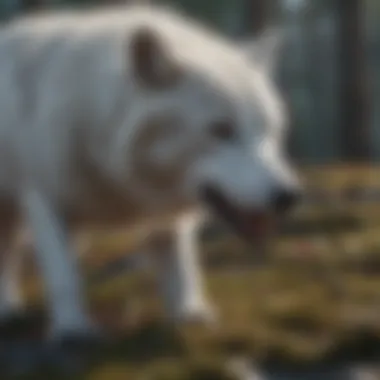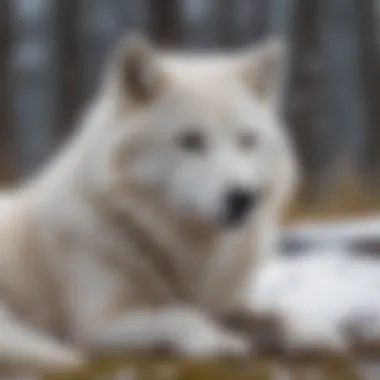Exploring the Fascinating World of Arctic Wolves


Nature Topic Overview
The Arctic wolf, known scientifically as Canis lupus arctos, is a remarkable creature that inhabits the frigid landscapes of the Arctic tundra. These wolves are a subspecies of the gray wolf and have adapted uniquely to their harsh environment. Unlike their counterparts in more temperate regions, Arctic wolves have evolved physical and behavioral traits that enable them to thrive in extreme cold. They have a thick, white coat that not only keeps them warm but also provides camouflage against the snow.
Arctic wolves live in small packs that are typically family units. This social structure helps them hunt and raise their young more effectively. Learning about the behaviors, hunting strategies, and interactions within these packs can provide a greater understanding of their role in the ecosystem. The Arctic tundra, where these wolves roam, is a delicate environment, and the conservation of Arctic wolves is crucial to maintaining the balance of their ecosystem. Their survival is increasingly threatened by climate change and habitat loss.
By exploring the fascinating world of Arctic wolves, we gain insights into their unique adaptations and the importance of protecting these magnificent animals in their natural habitat. This article aims to provide young readers and their families with engaging facts and detailed descriptions that will spark curiosity and promote environmental awareness.
Fun Facts and Trivia
- Coloration: The Arctic wolf's fur is not only white, but it can also be grayish or even brownish, depending on the season.
- Pack Dynamics: A typical pack consists of about 5 to 10 wolves, but exceptional packs can have more than 20.
- Diet: Arctic wolves primarily hunt seals, caribou, and small mammals. They are known for their excellent hunting skills in harsh conditions.
- Communication: These wolves communicate through howls, body language, and even facial expressions to coordinate with their pack.
"The Arctic wolf's resilience is a testament to nature's adaptability and the importance of protecting our planet."
To engage young readers, visuals depicting the Arctic wolf in its habitat can be instrumental. Pictures showing a pack in action or pups playing can make the information more relatable and exciting.
Wildlife Explorations
The Arctic wolf is not alone in its environment. Other species that share the tundra include reindeer, Arctic foxes, and snowy owls. Each of these animals has unique adaptations for thriving in the cold.
- Reindeer: These grazers have large hooves suitable for walking on snow. They migrate to find food during the harsh winter months.
- Arctic Fox: Smaller than the wolf, it feasts on small mammals and birds, using its keen sense of hearing to locate prey beneath snow.
- Snowy Owl: A top predator in the tundra, these owls hunt small mammals and have excellent vision in low light.
To supplement learning, interactive features like quizzes about Arctic wildlife can enhance engagement. Questions can range from identifying different species to understanding their habits and diets.
Environmental Awareness
The conservation of Arctic wolves is paramount to preserving the ecological balance of their habitat. Climate change poses significant threats to their existence. The melting ice and changing landscapes affect their hunting patterns and prey availability.
Children can play an important role in conservation efforts. Simple actions such as:
- Reducing waste by recycling
- Supporting wildlife organizations
- Learning about the importance of ecosystems
By understanding the critical nature of their environment, young learners can become advocates for wildlife protection.
DIY Nature Activities
Encouraging outdoor exploration can help children connect with nature. Here are a few activities:
- Create a Wolf Habitat: Use materials like cardboard, paper, and paint to create a model of the Arctic wolf's habitat. Include the elements necessary for survival.
- Nature Journaling: Encourage kids to take a walk outside and document what they find in nature. They can sketch animals or plants they observe.
- Wolf Mask Craft: Use simple materials to create wolf masks. This can be a fun way to learn about their features while engaging in a creative project.
These activities can help consolidate knowledge about the Arctic wolf while fostering a love for nature.
Prelims to Arctic Wolves
Understanding Arctic wolves is crucial for anyone interested in wildlife and ecology. This article dives into the life of these remarkable animals and the environment they inhabit. By examining their traits, behaviors, and roles in the ecosystem, we can appreciate their importance not only in the Arctic but also in the broader ecological balance. This introductory section sets the stage for deeper exploration into their unique adaptations and social structures. Knowledge about these wolves enhances our understanding of biodiversity and conservation challenges.
Understanding the Arctic Environment
The Arctic environment is one of the most extreme on Earth. The weather is cold with long winters and short summers. The temperatures can drop below freezing for most of the year. This harsh climate influences every living thing, including Arctic wolves.
There are limited plants in this region, mainly consisting of mosses, lichens, and low shrubs. These plants play an essential role in the ecosystem. They not only provide food for animals but also help to maintain the soil and atmosphere.
Arctic wolves are specially adapted to survive in this icy landscape. Their thick fur and padded feet help them traverse the snow-covered ground with ease. Moreover, they have keen senses that enable them to hunt and thrive despite the challenges of their environment. Understanding these characteristics helps to appreciate how life can adapt and flourish even in the most difficult conditions.


General Overview of Wolves
Wolves are social animals, and they play a significant role in their habitats as apex predators. There are multiple species of wolves around the world, but the Arctic wolf, Canis lupus arctos, is distinct. They are characterized by their smaller size and lighter coloration compared to other wolf species. Such features are advantageous for camouflage in snowy terrains.
Wolves generally live in packs, which are structured groups that work together to hunt and care for their young. The pack is often made up of a breeding pair and their offspring, fostering strong family bonds. This social structure is crucial for their survival because it enhances their hunting efficiency and helps protect against threats.
Key Points:
- Arctic wolves are uniquely adapted to their frigid environment.
- The Arctic ecosystem is harsh, but life still thrives within it.
- Wolves worldwide are social, living in structured packs, promoting cooperation.
"Wolves have a vital role in their ecosystems, and through understanding them, we can better protect the environment."
Through comprehending the basic features of Arctic wolves, we set a solid foundation for exploring their distinctive physical traits, behavioral patterns, and conservation status.
Physical Characteristics
Understanding the physical characteristics of Arctic wolves is essential. Their unique traits are not just appealing to observe, but also crucial for their survival in an unforgiving environment. Physical attributes such as coloration, size, and special adaptations offer insights into how these wolves thrive in icy landscapes. This section will delve into these aspects to shed light on the remarkable resilience and specialized nature of Arctic wolves.
Coloration and Size
Arctic wolves exhibit distinct coloration that aids in their survival. Their fur is primarily white or light gray, allowing them to blend seamlessly into the snowy surroundings. This camouflage is a vital defense mechanism against prey and potential threats. Size also plays an important role. Adult Arctic wolves typically weigh between 75 to 120 pounds and can reach lengths of about 4 to 6 feet. This size gives them an advantage when hunting larger prey, as they can work more effectively in groups to take down animals like caribou.
Adaptations to Cold Climate
Adaptations of Arctic wolves to the cold climate are fascinating. Their thick fur serves as insulation, keeping them warm during chilling temperatures that can drop to -40 degrees Fahrenheit. Beneath their fur, a layer of fat also provides energy reserves and adds to their temperature regulation. Their paws are larger than those of other wolf species, which helps them navigate through deep snow without sinking. This specific adaptation is crucial for their hunting efficiency in winter conditions.
Unique Features of Arctic Wolves
Several unique features distinguish Arctic wolves from their relatives. First, their breeding patterns are adapted to the Arctic cycle. They usually breed in late winter, ensuring pups are born in spring when food is more abundant. Furthermore, Arctic wolves are social animals that thrive in packs, which often consist of a mated pair and their offspring. This pack dynamic not only strengthens their hunting capabilities but also enhances the survival of the young.
Overall, the physical characteristics of Arctic wolves are a captivating aspect of their biology, reflecting how they have evolved to survive and thrive in one of the most challenging environments on Earth.
Behavioral Traits
Understanding the behavioral traits of Arctic wolves is essential in appreciating their individuality and how they survive in extreme conditions. These traits highlight the complexities of their social interactions, communication, and hunting strategies. The behavioral patterns exhibited by these wolves are vital for their survival and play a significant role in their ecosystem. In this section, we will explore three key aspects: the social structure of packs, communication methods, and hunting and feeding habits. Each element contributes to the overall success of Arctic wolves as a species in the harsh Arctic environment.
Social Structure of Packs
Arctic wolves typically live in family groups called packs. These packs can vary in size, often consisting of the alpha male and female and their offspring. The social structure is hierarchical, with the alpha pair leading the group in decision-making and hunting. Young wolves learn essential skills from observing their parents and other pack members. This learning is crucial for their survival when they become independent.
The presence of an organized pack structure allows for effective hunting, as wolves work together to take down larger prey. In the Arctic, caribou and musk oxen are significant food sources. By hunting in teams, Arctic wolves have a higher chance of success compared to lone hunters.
Communication Methods
Communication among Arctic wolves is essential for coordination within the pack. They use various vocalizations to express different meanings. For example, howls can signal location, gather pack members, or intimidate rivals. These vocalizations are powerful tools in the frozen landscape, where sound travels well.
In addition to howling, Arctic wolves also utilize body language to convey emotions and intentions. Tail position, ear orientation, and facial expressions play a role in interactions. Understanding these signals helps maintain harmony within the pack and strengthens social bonds.
Hunting and Feeding Habits
Hunting and feeding habits of Arctic wolves reveal their remarkable adaptability. As primarily carnivorous animals, their diet consists mainly of large ungulates such as caribou. They are known for their endurance, often traveling long distances to locate prey in the expansive tundra. These wolves employ strategies like stalking and chasing to secure their meals.
Once they have successfully hunted, Arctic wolves exhibit fascinating feeding behaviors. They often allow the alpha wolves to eat first, ensuring that the leaders are well-fed. After the alpha pair, other pack members share the remains. This practice reinforces their social structure and demonstrates the importance of leadership and cooperation.
"The cooperation displayed in hunting and pack structure is vital for the survival of Arctic wolves in their harsh habitat."


Habitat and Distribution
Understanding where Arctic wolves live is crucial for grasping their way of life. Their habitat significantly influences their behaviors and survival strategies. The Arctic environment presents challenges that the wolves have adapted to over generations. This adaptability helps maintain the balance of the ecosystem in this unique region. Studying their habitats provides insight into how species survive in extreme conditions.
Geographical Range of Arctic Wolves
Arctic wolves predominantly inhabit the northern regions of North America and Greenland. Their range includes Canada, Alaska, and some parts of the Arctic Archipelago. Their geographical distribution is closely tied to the cold tundra environments, which offer sufficient prey and shelter.
The extent of their range allows the Arctic wolf to thrive in various landscapes but remains limited by the harsh climatic conditions. For example, the specific characteristics of the Arctic tundra, such as permafrost and seasonal changes, shape their living spaces.
Typical Habitats in the Arctic
Arctic wolves are found mainly in open tundra, where they roam vast distances. These habitats provide many essential resources, including prey and adequate shelter. The typical environments include:
- Tundra: A cold desert-like area with minimal vegetation, which is ideal for hunting.
- Coastal regions: Areas near the sea where food is abundant, and access to different prey increases.
- Ice fields and rocky terrains: These locations provide cover and places to den and raise their pups.
In summary, the habitat of Arctic wolves is specifically adapted to the cold, stark landscapes where they thrive. The knowledge of their distribution and typical habitats is vital in understanding their survival strategies and conservation needs.
"The ecosystem's balance depends on the presence of each species, including the Arctic wolf."
Their habitats not only support their survival but also the entire biodiversity of the Arctic ecosystem.
Reproductive Behavior
Reproductive behavior in Arctic wolves is essential for their survival and the continuation of their species. During this process, certain traits become prominent that highlight the complex social dynamics within wolf packs. Understanding these behaviors not only sheds light on their mating rituals but also on the overall structure of the pack and its functioning.
Arctic wolves usually breed in late winter, a season that allows pups to be born when food is more accessible during the spring months. This timing creates a balance, ensuring that resources are available for the mother and her young.
Breeding Seasons and Mating Rituals
Mating season for Arctic wolves typically occurs between late February and early March. During this time, females enter their estrus phase, making them receptive to males. Males, known for their keen sense of smell, can detect a female's readiness from miles away.
The courtship involves elaborate displays of behavior. Males may exhibit playful gestures and vocalizations. The pair often engages in a series of rituals including nuzzling, tail wagging, and synchronized howling. These interactions strengthen the bond between the pair, confirming their commitment to one another.
"Mating among Arctic wolves is not only about reproduction; it also solidifies social bonds within the pack."
After mating, the female will typically choose a den site, where she will give birth to her pups. This den is usually hidden to protect the young from predators.
Pup Development Stages
Once born, Arctic wolf pups go through several developmental stages. The first few weeks are critical for their survival. Here’s how their growth unfolds:
- Birth to Two Weeks: Pups are born blind and deaf. They rely entirely on their mother's warmth and milk.
- Two to Four Weeks: Their eyes begin to open, and they start to hear. At this stage, they become more aware of their surroundings but remain dependent on their mother.
- One to Two Months: Pups begin to crawl out of the den. They start exploring their environment, playing with siblings, and developing motor skills.
- Two to Three Months: By this time, they start to eat soft food provided by their parents, transitioning from milk to solid food. The mother may bring back pieces of prey for them to consume.
- Three to Six Months: Pups grow stronger and begin practicing hunting skills. They join their parents on small hunts, learning the skills necessary for survival.
Throughout these stages, the involvement of the entire pack in the care and teaching of the pups is crucial. All members contribute to their upbringing, strengthening the social fabric of the group.
Conservation Status
The conservation status of Arctic wolves is a critical aspect of understanding their survival and existence in the harsh environment of the Arctic tundra. As a unique subspecies, these wolves face various threats that challenge their continued presence in their native habitat. Recognizing and addressing these threats is essential for the protection of Arctic wolves and the balance of their ecosystem. Conservation efforts are pivotal in ensuring the longevity of this species and their habitat.
Threats to Arctic Wolves
Arctic wolves encounter several threats that jeopardize their population. These include:
- Climate Change: The changing climate profoundly affects the ice and snow that are crucial for their habitat. Warming temperatures lead to a decline in the prey species, altering the food chain.
- Human Encroachment: As human activity increases in Arctic regions, such as mining and oil drilling, it disrupts the natural environment. This invasion can lead to habitat loss and increased human-wolf conflicts.
- Pollution: Pollutants can accumulate in Arctic regions, impacting the health of both the wolves and their prey. Contaminants like chemicals and heavy metals can compromise immune systems and reproductive success.
Understanding these threats is the first step towards effective conservation measures.


Conservation Efforts and Challenges
Various organizations and governments have initiated conservation efforts aimed at protecting Arctic wolves. These efforts include:
- Protected Areas: Establishing national parks and reserves ensures that large expanses of the Arctic are safeguarded from human exploitation.
- Research and Monitoring: Ongoing studies and monitoring programs help scientists understand wolf populations, their health, and the effectiveness of conservation strategies. This data is crucial for adapting management plans appropriately.
- Community Involvement: Engaging local communities in conservation efforts fosters a sense of ownership and responsibility towards Arctic wolves. Educating residents about the importance of these wolves can lead to more sustainable coexistence.
Despite these efforts, several challenges persist. Funding for conservation programs can be limited, and political priorities might shift. Climate change remains a pressing issue, making long-term predictions difficult. Collaboration between nations and various stakeholders becomes essential in addressing these challenges effectively.
"Conservation is not merely a preservationist movement but a global necessity to maintain our ecosystems and their inherent value."
In summary, the conservation status of Arctic wolves is a multifaceted issue. Understanding the threats they face and implementing concerted conservation efforts are vital for their survival. This continued work benefits not just this remarkable species, but also the broader ecosystem they help sustain.
Interesting Facts
The Arctic wolf is an enthralling creature that captivates many because of its unique traits and adaptations. Knowing these interesting facts provides insights into their survival strategies and role in the harsh Arctic environment. It enables readers, especially young learners, to appreciate the biodiversity of our planet and understand the significance of protecting such species.
Unique Behaviors and Traits
Arctic wolves exhibit behaviors that set them apart from their counterparts. One significant behavior is their seasonal activity patterns. Unlike some wolves that may be more active at dusk or dawn, Arctic wolves often hunt during the day. This might be due to the prolonged hours of daylight in summer.
These wolves also demonstrate an ability to travel vast distances. They can cover large areas in search of food. Their strong sense of smell helps them locate prey even under thick snow. In a pack, they have structured roles during hunting, which improves their efficiency and success rate.
Another captivating trait is their social structure. Arctic wolves typically communicate through a range of howls. Each howl carries specific meanings, whether calling to pack members or warning of an intruder. This form of communication is vital to their survival, as they live in harsh conditions that can isolate members.
- Hunting strategies include:
- Teamwork during hunts
- Utilizing their knowledge of terrain
- Adapting techniques based on prey size
Understanding these behaviors highlights the intelligence and adaptability of the Arctic wolf, setting an example for resilience in challenging environments.
Cultural Significance of Arctic Wolves
Arctic wolves hold a prominent place in the cultural narratives of indigenous communities. They often symbolize strength, family, and survival. Stories and folklore have depicted these wolves as resilient beings, embodying the values of teamwork and loyalty.
For many indigenous peoples, the Arctic wolf represents a connection to nature. This connection is essential for maintaining ecological balance in tundra regions. Art and literature inspired by Arctic wolves reflect their importance in the local heritage.
- Key cultural aspects include:
- Storytelling that highlights wolf characteristics
- Art portraying wolves as symbols of endurance
- Celebrations that honor the natural world and its creatures
The cultural significance emphasizes respect for wildlife and the environment. It fuses educational aspects with moral lessons, making the Arctic wolf not just an animal but also an emblem of cultural stories that weave through generations.
Finale
The conclusion serves as a crucial component in this exploration of Arctic wolves, tying together the essential elements discussed throughout the article. Each section unveiled unique aspects of the Arctic wolf's life, from their distinctive physical traits to their vital role in the ecosystem. Understanding these factors highlights how these remarkable creatures adapt and thrive in extreme conditions.
Summary of Key Points
To summarize, the Arctic wolf is not just a unique subspecies of wolves but also an important indicator of the health of the Arctic ecosystem. Key points covered include:
- Physical Characteristics: Arctic wolves possess thick white fur, which not only camouflages them in their snowy environment but also insulates against extreme cold. Their size and build are specifically adapted for survival in harsh climates.
- Behavioral Traits: Social structures are fundamental to their way of life. They live in packs that work together for hunting and raising pups. Their communication methods are vital in maintaining pack unity and strategy.
- Hunting Strategies: Their diet primarily consists of caribou and other prey, and they exhibit sophisticated hunting methods that show their intelligence.
- Conservation Status: The threats faced by Arctic wolves include climate change and habitat loss. Conservation efforts are critical to ensure their survival.
These points would help children to remember the fascinating attributes and traits of these wolves, as well as the real-world implications surrounding their existence.
Importance of Arctic Wolves in the Ecosystem
Arctic wolves are not just a species; they are an integral part of the Arctic ecosystem. Their role can be outlined as follows:
- Predator-Prey Relationships: As predators, they help maintain a balance in the populations of their prey. This regulation is crucial for the health of the plant life in their habitat.
- Indicator Species: Since they are highly sensitive to environmental changes, Arctic wolves can serve as an indicator of ecosystem health. Any significant drops in their population can signify issues within their habitat, such as climate change effects.
- Cultural Importance: These wolves hold cultural significance for many indigenous Arctic communities, symbolizing strength and resilience. This connection highlights the interconnectedness of species and their environments.
In summary, Arctic wolves play a significant role in sustaining the balance of their ecological community. Their survival impacts not only their immediate environment but also serves as a critical gauge for broader ecological changes.







